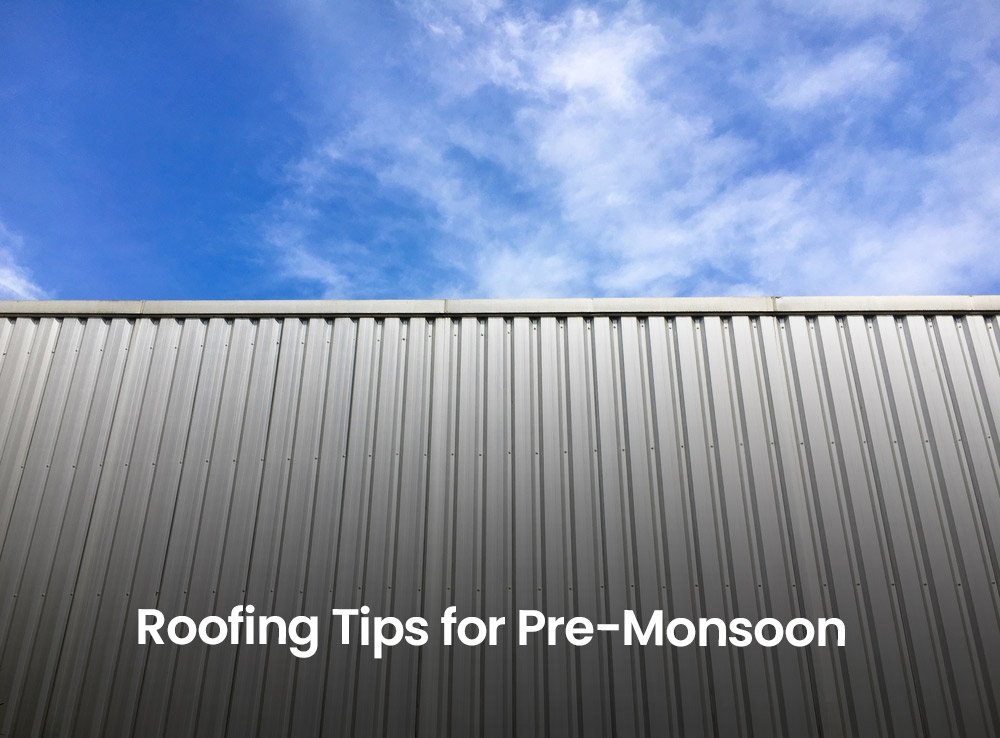Roofing Tips for Pre-Monsoon Maintenance

As monsoon season nears, it's essential that your roof is in top shape to handle heavy rainfall and strong winds. A well-kept roof can protect against water damage, leaks and costly repairs; we provide some helpful roofing tips for pre-monsoon maintenance here in this blog post to ensure it remains in great shape throughout its duration! So let's get down to work!
Tips for Pre-Monsoon Roofing Maintenance
Checkout the roofing tips for pre-monsoon maintenance
1. Get a roof inspection
One key step in preparing your roof for monsoon season is scheduling a professional inspection to identify any issues which could cause leakage or damage during heavy rainfall. A roof inspector can detect potential problems that could cause leakage or other forms of damage due to poor maintenance, leaks or heavy rainfall.
During an inspection, a roofing contractor will look for signs of wear and tear, such as missing or damaged sheets, cracked caulking around vents and skylights and rusted flashing. They will also check if the roof's drainage system is working correctly by ensuring there are no clogs in gutters or downspouts.
2. Clear gutters and downspouts
Over time, leaves, twigs, and other debris can accumulate in your gutters, causing blockages that prevent rainwater from properly draining off your roof. This can cause water damage to your roof or even lead to leaks inside your home.
To clean out your gutters, start by clearing away large debris with a scoop or trowel, followed by using a hose to flush away smaller particles with clean water from the downspouts and ensure water runs freely down them and doesn't pool on top of your roof. Ensure the downspouts remain clear to ensure a proper flow rate so as not to pool on top.
3. Clear Debris and Fungal Growth
Accumulated debris can clog gutters, leading to water overflowing into your home through leaky drains or cause overflow from overflowing drains, leading to leakage from overflowing drains or overflowing drains and eventually flooding in through leakage points. Therefore, any such accumulation must be cleared away before monsoon season hits.
Additionally, it's also important to inspect for fungal growth on your roof, which could weaken its materials and cause leaks or other forms of damage. You can spot fungal growth by searching for green or black patches on sheets or tiles.
4. Check for loose or damaged sheets
One of the crucial pre-monsoon maintenance tasks for your roof is to check for loose or damaged sheets. Loose and damaged sheets can lead to leaks during heavy rainfall, which can cause severe damage to your property.
Start by visually inspecting your roof from ground level and look for any signs of missing or out-of-place sheets, tiles, or metal sheets. If you spot any issues, it's essential to address them promptly to prevent further damage. Fixing minor damages yourself is possible using materials such as silicone caulking, but major repairs are best left in professional hands. In general terms, addressing problems sooner rather than later will save money long-term while ensuring overall safety throughout monsoon season!
5. Inspect flashing and seal any gaps
During pre-monsoon maintenance, it's important to inspect the flashing and seal any gaps to prevent water from seeping in. Flashing is a thin layer of metal placed over roof joints, valleys, and other vulnerable areas to direct water away from these spots. Over time, flashing can become loose or damaged due to weather conditions such as high winds or hail.
Pay special attention to areas where different types of materials meet, such as chimneys or vents where flashings are particularly prone to failure over time due to expansion and contraction caused by varying temperatures. By regularly checking flashing in pre-monsoon maintenance inspections, you'll ensure its continued health.
6. Trim the Extra Tree's Branches
Trees can be a beautiful feature in any home, but their roots can cause significant damage during monsoon season. Therefore, it is crucial that any nearby trees are trimmed prior to heavy rainstorms arriving and being damaged by their roots. Overhanging branches can scrape against your roof and dislodge sheets or tiles, leaving gaps for water to seep through. Additionally, falling branches can puncture holes in your roof and result in costly repairs.
To avoid these issues, trim back any tree branches that hang over or near your roof. It's best to hire a professional tree trimming service if you're not experienced with using power tools or climbing ladders. By taking care of this task early on in the pre-monsoon maintenance process, you'll have peace of mind knowing that your roof is protected from potential damage caused by overgrown trees.
7. Hire a professional roofing contractor
Professional contractors have the expertise, experience, and tools required to identify potential problems that could lead to expensive repairs in the future. Before hiring a contractor, it's best to do some research on their reputation and credentials. Ensure they are licensed, insured, and have positive reviews from previous clients.
Professional contractors can perform an extensive inspection of your roof, identifying any potential issues, such as leaks or damaged sheets. They can also provide recommendations on how to improve the overall condition of your roof before the monsoon season hits.
Conclusion
Maintaining your roof is crucial to ensure the safety and protection of your home during monsoon season. By following these pre-monsoon maintenance tips, you can avoid serious damage to your roofing system.
Remember that regular maintenance of your roof not only increases its lifespan but also saves you money in the long run by avoiding costly repairs. Take proactive measures now before it's too late!
We hope these tips have been helpful in preparing you for the upcoming monsoon season!
Oralium has been delivering roofing solutions that best match the climatic conditions in India. Choose Oralium for the right roofing requirements. Oralium Aluminium Roofing Sheets are available in varied options including Oralium Strong, Oralium Grantile, Oralium Wide, Oralium Novatile and more.
Feel free to contact us for your enquiries.